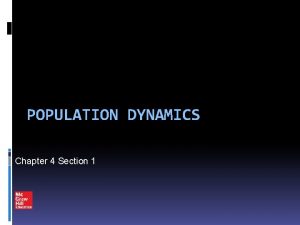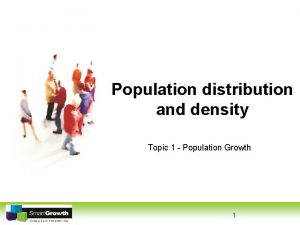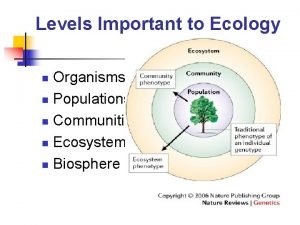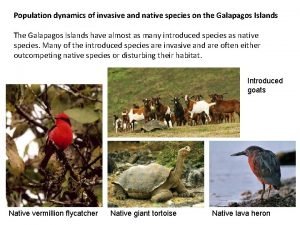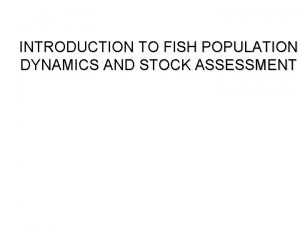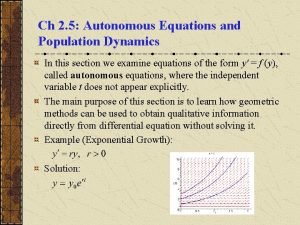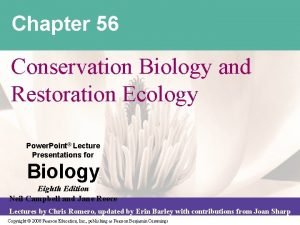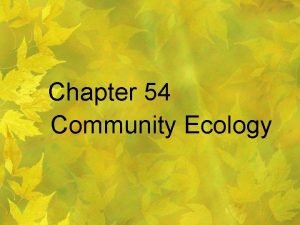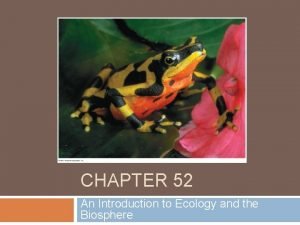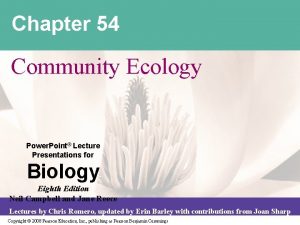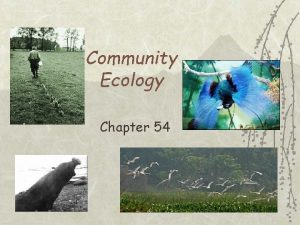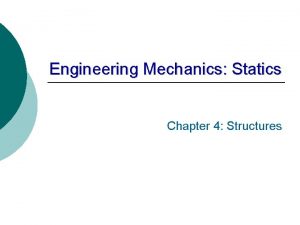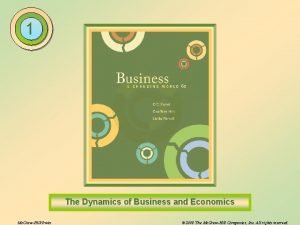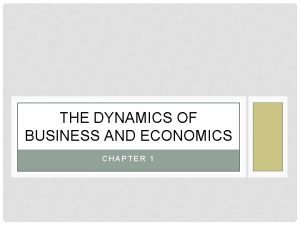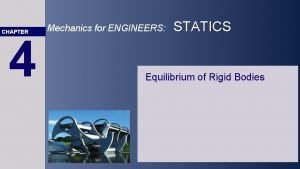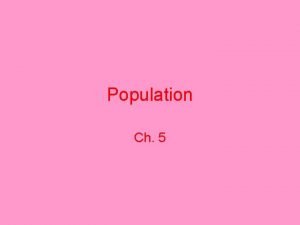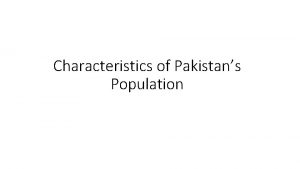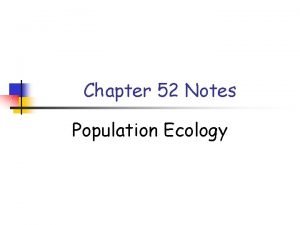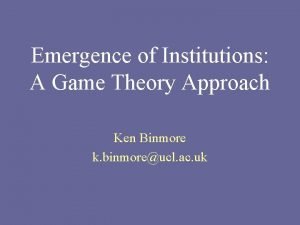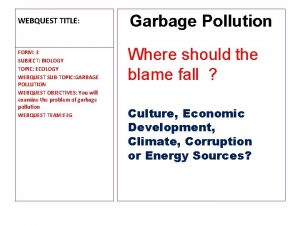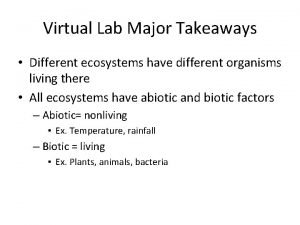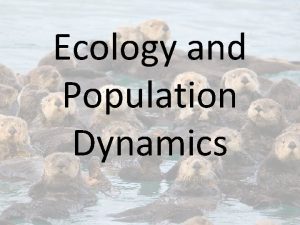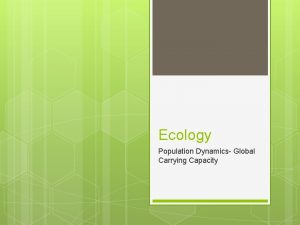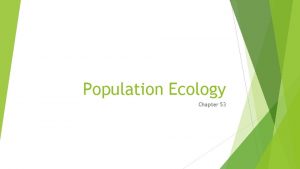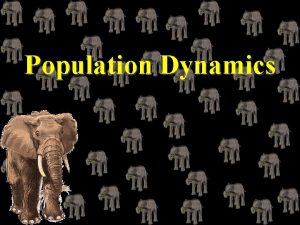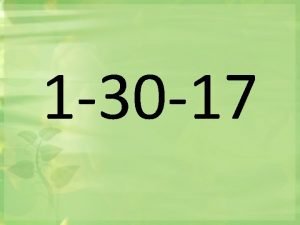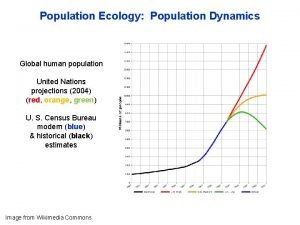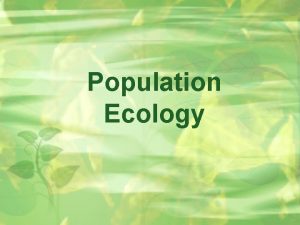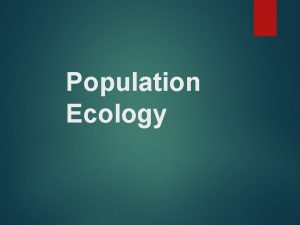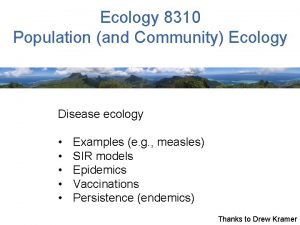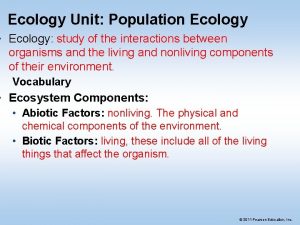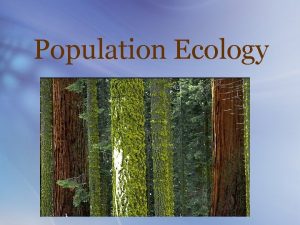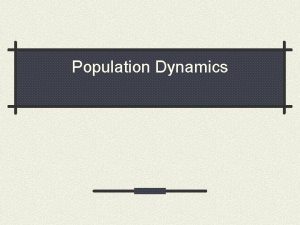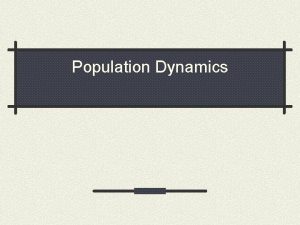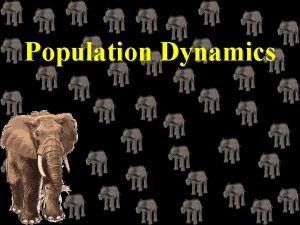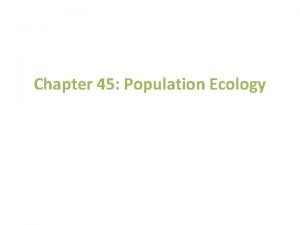Population Ecology Population Dynamics Chapter 4 Population Characteristics





















































- Slides: 53

Population Ecology Population Dynamics Chapter 4

Population Characteristics � Population- group of organisms of the same species in the same area � Population characteristics include: ◦ Density, spatial distribution and growth rate � Population an area Density- number of organisms in ◦ 38 deer/square mile in NJ

Dispersion Patterns Uniform (solitary) � Groups are evenly spaced � Members often don’t want to be near each other

Dispersion Patterns Clumped (herds) � Members are usually social � Members are usually around important resources

Dispersion Patterns Random (groups) � Not centered around a certain resource � Some members are social, some are not

Limiting Factors � Keep populations from growing indefinitely ◦ Without these, populations would infinitely large � Can be abiotic � Can be biotic ◦ Hiding places ◦ Temperature ◦ Rainfall ◦ Food ◦ Predators ◦ Disease

Density Independent Limiting Factors � Does not depend on the number of organisms in an area � Usually abiotic ◦ Weather (floods, temperatures, hurricanes)

Density Dependent Limiting Factor � Depends on Density � Often Biotic ◦ Parasites, Predators, Disease, Competition

Population Growth � Population growth ratemeasure of how fast a population grows � Birth and Immigration increase Populations � Death and Emigration decrease populations Growth rate Death rate Emigration rate r = (b – d) + (i – e) Birth rate Immigration rate

Exponential Growth � Growth without limiting factors � J shaped Curve ◦ Exponential growth � Many young survive � Cannot occur forever! ◦ Why?

Logistic Growth � Population Strains Resources � Growth will slow or stop � Fluctuates around a carrying capacity (K) � S- Shaped

Carrying Capacity � Carrying Capacity- the maximum number of individuals that the environment can support for the long term � Limited by nutrients, oxygen, and water

Reproductive Strategies r-selected � Many young � Reproduce quickly � Little parental care � Small in size � Examples: ◦ Insects ◦ Plants (esp weeds) ◦ Frogs

Reproductive Strategies k-selected � Large organism � Much parental care � Mature Late � Few Young � Examples: ◦ ◦ Kangaroo and Koala Humans Redwood trees Whales

Human Populations Humans change their environment to increase carrying capacities � Technologies reduce death rates � ◦ Medicine 70 million new people every year � 53 years to double the population � Growth rate is slowing � ◦ AIDS ◦ Voluntary Population Control � Ie. China – One Child Policy


Trends � Developed countries have a lower birth rate and later date rate ◦ USA (2009)- 13. 9/1000 ◦ USA (1850) 50/1000 � Why? � Zero death @ 78. 11 years old death @ 38. 3 years old population growth, so… ◦ Birthrate + Immigration rate = Death rate + emigration rate

Age Structure Diagrams

More Age Structure Diagrams

9 Week Test Let’s take a minute to talk

Grading Policy � All marking periods and final exam is worth 20% according to new school policy ◦ No midterms ◦ So finals count more!

What are we doing? � 9 week, 18 week 27 week, and 36 week exams ◦ Will help prepare you for the EOC Bio Test ◦ Grade goes on the individual marking period.

What to know for 9 week… � Food chain and food web ◦ producer/autotroph, consumers (herbivores, carnivores, omnivores) ◦ Arrow indicates flow of energy ◦ Trophic levels ◦ Pyramid of energy and biomass – 10% rule � Symbiotic relationships ◦ Mutualism, commensalism, parasitism � Biodiversity and biomes ◦ Tropical rainforest have most biodiversity � Read and interpret graph

More topics � Photosynthesis – who does it, what is it? ◦ Uses CO 2 and water to make glucose and release oxygen � Respiration – opposite of photosynthesis ◦ Uses oxygen to break down glucose, release water and CO 2 � Indicator species – ex. Amphibians ◦ What will happen to insects if lose frogs? What about snakes? � Cycles – water, carbon, phosphorus, nitrogen, and greenhouse � Population studies◦ S and J curves � Microscope

Biodiversity and Conservation

Biodiversity � Biodiversity-variety of life � Extinction- no more member of a species exists � Genetic diversity- variety of genes in a population ◦ Higher diversity offers a better chance to survive a disaster ◦ Some individuals are naturally resistant to some disease �Humans and AIDS (delta 32 mutation)

Species Diversity � Species Diversity- number of different species and the abundance in an area � What biomes have a higher diversity?

Why preserve Biodiversity? � We yet may not know the benefit of an organisms ◦ Aspirins-from willow ◦ Penicillin comes from mold ◦ What's next? � Healthy diversity ◦ Leads to healthy watersheds ◦ Clean drinking water � Its beautiful

Conservation Extinction Rates � Background extinction- gradual process of a species going extinct ◦ Always present ◦ Caused by natural processes, climate change, natural disasters � Mass extinction- large percentage of all living species become extinct in a short time ◦ Dinosaurs 65 million years ago

Extinctions � 73% of extinct mammals over the last 500 years are island species ◦ Why? � Many of Hawaii's birds are extinct ◦ Ground nesters – ie saffron finches � Amphibians danger ◦ Why? are currently in

Threats � Humans- change natural conditions faster than organisms can adapt � Humans- Overexploitation ◦ 50 million bison dwindled to 1000 in 1889 � Overexploitation may lead to extinction � Humans-habitat loss ◦ Passenger pigeon (next slide) ◦ Not enough food ◦ Changed weather patterns

Passenger Pigeon � � � About 5 billion in N. American in 1600 s-1700 s Up to 90 nests /tree collapsed branches Migrating flocks shadowed sky 9 am-4 pm ◦ If shoot gun randomly – birds would fall from sky ◦ Good food � � Females lay one egg a year Population decline – lost habitat and hunted ◦ Stool pigeon – name came from passenger pigeon � Community bird – like to be in groups � Capture pigeon, tie to stool, stitch eyes shut so cry, move pigeon around while shrieking to attract other pigeons � Last one died in zoo - 1914

Bison Slaughter � Bison hunted for sport � Skulls used as fertilizer � Purpose of Bronx Zoo was to replace the bison herds ◦ Now – people grow bison for meat

Habitat Disruption � Changing on thing can have a big effect ◦ Whales disappear then plankton bloom ◦ ADD: Dodo bird � Habitat Fragmentation- separating an ecosystem into small areas � Edge effect- temperature, humidity and species are different at edges than interiors ◦ Overlap makes the area unique


Biomagnification � Pollutants build up to high levels in carnivores � The pollutants are fat soluble � They enter the food chain at low levels � Examples ◦ DDT- kills mosquitoes and other insects ; accumulates in birds (ie eagles) affects egg shells ◦ Mercury- accumulates in humans causing problems with the nervous system (vision, hearing and speech) ◦ Dioxin- causes organ disease, increased risk of cancer and a suppressed immune system

Add… Dioxins released when plastics are burned

Acid Precipitation � Caused by burning fossil fuels � Sulfuric acid and nitric acid are formed � Acid rain falls back as rain, snow fog or sleet � Acid rain removes nutrients from soil and kills fish and other organisms

Invasive Species � Introduced or invasive species have been moved to their habitat � Organisms are not kept in balance by natural means � Examples ◦ Cane Toads ◦ Fire Ants ◦ Phragmities (the plant in the Meadowlands) ◦ Kudzu – coming up!


Kudzu Arrives � Came to US in 1876 at Japan exhibit of the Centennial � In 1930’s – used to halt soil erosion � Promoted as “miracle vine” until 1953 � Is a legume – adds N to soil � Flowers are pretty

Kudzu Today � Not under control but learn to live with � Vines used for baskets ◦ Free material! ◦ Expensive basket � Bread and jelly � Provides digestive nutrients ◦ Crohn’s disease – difficult digesting food �Kudzu soup – made from solid; people who have Crohn’s swear by ti

Kud-Zoo

Zebra Mussels � First noticed in Great lakes in 1988 � Can live for days and weeks out of water ◦ If temperature and humidity is high � 1 adult female produces between 30, 000400, 000 eggs per year � Filter feeders ◦ Increase light penetration ◦ Increase algae growth

Between ¼ and ½ in long � Razor sharp shells cut 1 in into human flesh � ◦ so fine no realize cuts � Cover may things ◦ Cost of damage is in billions of dollars

The spread…

Wild Hogs � From Europe ◦ Hernando De. Soto brought wild boars to FL for food and hunting � Bred with feral and domestic hogs � Today- wild hogs are damaging land in 39 states ◦ Damage ~1. 5 billion/year

Bad piggies � Opportunistic omnivores ◦ Will eat anything ◦ Wipe out native plant species � Destroy crops, dig up seeded fields � Erode soil, muddy stream � Eat deer, livestock and bird and turtle eggs � Hard to catch – run 30 mph and can detect odors 7 miles away or 25 ft underground

Range has spread � As far north as south NJ

Conservation � Industrialized countries use more resources � Renewable resource- replaced by natural processes � Nonrenewable- finite amount of the resource available � Which are renewable and which are not Fossil Fuels Water Timber Kenaf Solar Radiation Hydropower Metals

Sustainable Use � Resources must be used at a rate they can be replaced � All resources need to be used in an sustainable manner ◦ Nonrenewable resources �Fossil Fuels �Metals ◦ Renewable resources �Timber �Seafood

Hot Spots � 15% of the Earth Surfaces is considered a Hot Spot � There are many endemic species ◦ They only exist at that location � 70% of this habitat is lost

Should we restore ecosystem? � What � How ecosystems should be restored? should we do it? ◦ Bioremediation-remove toxins by using living organisms ◦ Bioaugmentation- adding natural predators
 Chapter test a chapter 4 population ecology answer key
Chapter test a chapter 4 population ecology answer key Chapter 4 population ecology section 1 population dynamics
Chapter 4 population ecology section 1 population dynamics Population ecology section 1 population dynamics
Population ecology section 1 population dynamics Population ecology section 1 population dynamics
Population ecology section 1 population dynamics What is uniform dispersion
What is uniform dispersion Population characteristics
Population characteristics Chapter 53 population ecology
Chapter 53 population ecology Equilibrial life history
Equilibrial life history Ecology
Ecology Chapter 53 population ecology
Chapter 53 population ecology Section 1 population dynamics answer key
Section 1 population dynamics answer key Chapter 53 population ecology
Chapter 53 population ecology Study guide chapter 4 section 1 population dynamics
Study guide chapter 4 section 1 population dynamics Logistic growth ecology definition
Logistic growth ecology definition Logistic growth ecology definition
Logistic growth ecology definition Fig 52
Fig 52 Population vs community ecology
Population vs community ecology Concept 3 population ecology
Concept 3 population ecology Ecology def
Ecology def What is population ecology
What is population ecology Population definition ecology
Population definition ecology Population distribution
Population distribution Parasitism
Parasitism Galapagos
Galapagos Fish population dynamics and stock assessment
Fish population dynamics and stock assessment Autonomous equations and population dynamics
Autonomous equations and population dynamics Chapter 52: an introduction to ecology and the biosphere
Chapter 52: an introduction to ecology and the biosphere Chapter 3, section 1: community ecology answer key
Chapter 3, section 1: community ecology answer key Chapter 56 conservation biology and restoration ecology
Chapter 56 conservation biology and restoration ecology Phosphorus cycle pearson education
Phosphorus cycle pearson education Chapter 54 community ecology
Chapter 54 community ecology Chaparral climograph
Chaparral climograph Organism
Organism Section 1 organisms and their relationships
Section 1 organisms and their relationships Section 1 organisms and their relationships answer key
Section 1 organisms and their relationships answer key Chapter 2 principles of ecology answers
Chapter 2 principles of ecology answers Chapter 54 community ecology
Chapter 54 community ecology Chapter 55 ecosystems and restoration ecology
Chapter 55 ecosystems and restoration ecology Chapter 5 evolution and community ecology
Chapter 5 evolution and community ecology Ecosystems interactions
Ecosystems interactions Principles of ecology section 2 flow of energy
Principles of ecology section 2 flow of energy Chapter 54 community ecology
Chapter 54 community ecology Chapter 4 cultural dynamics in assessing global markets
Chapter 4 cultural dynamics in assessing global markets Standard cycle market example
Standard cycle market example Statics of structures
Statics of structures The dynamics of business and economics
The dynamics of business and economics Chapter 1 the dynamics of business and economics
Chapter 1 the dynamics of business and economics A crane
A crane Characteristics of population
Characteristics of population Pakistan characteristics
Pakistan characteristics Population characteristics
Population characteristics Binmore
Binmore Ecology webquest answers
Ecology webquest answers Food chain virtual lab
Food chain virtual lab












